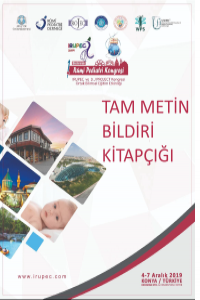Abstract
Headaches, which are one of the most frequent causes of admission to pediatric neurology clinics, are rarely associated with a serious medical condition and have been classified as primary and secondary headaches by the International Headache Association (1) The third subset includes neuropathies, facial pain and other headaches.
Primary pediatric headache disorders include migraines, migraine variants, tension-type headaches, and the trigeminal autonomic cephalalgias. Several etiologies have been defined for secondary headaches in children. The International Classification of Headache Disorders, 3rd Edition (ICHD-3), broadly categorizes secondary headaches into the following: headaches due to trauma, headaches due to cranial or cervical vascular disorders, headaches attributable to nonvascular intracranial disorders, headaches attributable to substance abuse or withdrawal, headaches due to infection, headaches due to disorders of homeostasis, headaches/facial pain due to disorders of the head or facial structures, and headaches due to psychiatric disorders. Considering the general diagnostic criteria for a secondary headache, the temporal relationship between headache onset and the presumed cause should be defined. Specifically, the headache should worsen in relation to the underlying cause and/or improve with treatment or resolution of the presumed cause and have characteristics typical for the disorder (1).
The existence of a secondary cause needs to be ruled out in children and adolescents by using physical examination and laboratory techniques. Using a bundle which consists of blood tests and cranial imaging in every patient with a headache due to medicolegal concerns causes loss of resources and time. In addition, false positive test results and incidental findings increase medical cost and time loss. For this reason, it is necessary to increase the experience of clinicians with studies conducted in pediatric patient populations presenting with a headache.
Material and Methods
This retrospective, descriptive, single-center study was conducted at the department of Pediatric Neurology of Muğla Sıtkı Koçman Research and Training Hospital, Muğla, Turkey. One hundred sixty (n:160) children (93 boys and 67 girls) between 6 and 18 years of age who were admitted to the pediatric neurology clinic with a headache between June 2018 – June 2019 were evaluated for the study.
A participant was excluded if he or she or a parent: 1) was unwilling to participate in this study, 2) had incomplete hospital records.
In our clinic, headaches are classified according to the International Classification of Headache Disorders proposed by the Committee of the International Headache Society, 2017 (IHS) (1). Classification of the patients were made by type of primary headaches (migraine, tension-type, cluster and other), etiology of secondary headaches (attributable to trauma or injury to the head or neck, cranial or cervical vascular disorders, sudden drug cessation or withdrawal, infections, disorders of homeostasis or headache or facial pain attributable to other facial and cervical structures). Also, age, gender, patient and family medical history, initial headache such as duration, location, duration of episodes, cranial MRI and EEG findings (if applied) were recorded.
Cranial MRI results were classified as normal or abnormal. EEGs were classified as normal or epileptic abnormalities
Twenty red flags were evaluated if asked or recorded; systemic symptoms, history of neoplasm, neurologic deficit or dysfunction, sudden or abrupt onset, pattern change or recent onset of headache, positional headache, precipitated by sneezing, coughing, exercise, or Valsalva maneuver, papilledema, vomiting, progressive headache, painful eye with autonomic features, posttraumatic onset of headache, immunocompromised child or adolescent, painkiller overuse or new drug at onset of headache, onset under 3 years old, atypical presentation, comorbid seizures, consistently worse in the morning, existence of a visual aura, headache awakening from sleep at night (2,3). .
References
- Referanslar 1- Olesen J. From ICHD-3 beta to ICHD-3. Cephalalgia. 2016 Apr;36(5):401-2. doi: 10.1177/0333102415596446. Epub 2015 Jul 10. 2- Yonker M. Secondary Headaches in Children and Adolescents: What Not to Miss. Curr Neurol Neurosci Rep. 2018 Jul 30;18(9):61. doi: 10.1007/s11910-018-0865-z. 3- Lewis DW, Ashwal S, Dahl G, et al. Practice parameter: evaluation of children and adolescents with recurrent headaches. Report of the Quality Standards Subcommittee of the American Academy of Neurology and the Practice Committee of the Child Neurology Society. Neurology 2002; 59:490 – 498 4- Straube A, Heinen F, Ebinger F, von Kries R. Headache in school children: prevalence and risk factors. Dtsch Arztebl Int 2013; 110:811 – 818. 5- Gallelli L, Iannacchero R, De Caro E, et al. A questionnaire-based study on prevalence and treatment of headache in young children. J Headache Pain 2005; 6:277 – 280.
Abstract
References
- Referanslar 1- Olesen J. From ICHD-3 beta to ICHD-3. Cephalalgia. 2016 Apr;36(5):401-2. doi: 10.1177/0333102415596446. Epub 2015 Jul 10. 2- Yonker M. Secondary Headaches in Children and Adolescents: What Not to Miss. Curr Neurol Neurosci Rep. 2018 Jul 30;18(9):61. doi: 10.1007/s11910-018-0865-z. 3- Lewis DW, Ashwal S, Dahl G, et al. Practice parameter: evaluation of children and adolescents with recurrent headaches. Report of the Quality Standards Subcommittee of the American Academy of Neurology and the Practice Committee of the Child Neurology Society. Neurology 2002; 59:490 – 498 4- Straube A, Heinen F, Ebinger F, von Kries R. Headache in school children: prevalence and risk factors. Dtsch Arztebl Int 2013; 110:811 – 818. 5- Gallelli L, Iannacchero R, De Caro E, et al. A questionnaire-based study on prevalence and treatment of headache in young children. J Headache Pain 2005; 6:277 – 280.
Details
| Primary Language | English |
|---|---|
| Subjects | Health Care Administration |
| Journal Section | Congress Proceedings |
| Authors | |
| Publication Date | December 10, 2019 |
| Acceptance Date | January 15, 2020 |
| Published in Issue | Year 2019 Volume: 7 Issue: Ek - IRUPEC 2019 Kongresi Tam Metin Bildirileri |


